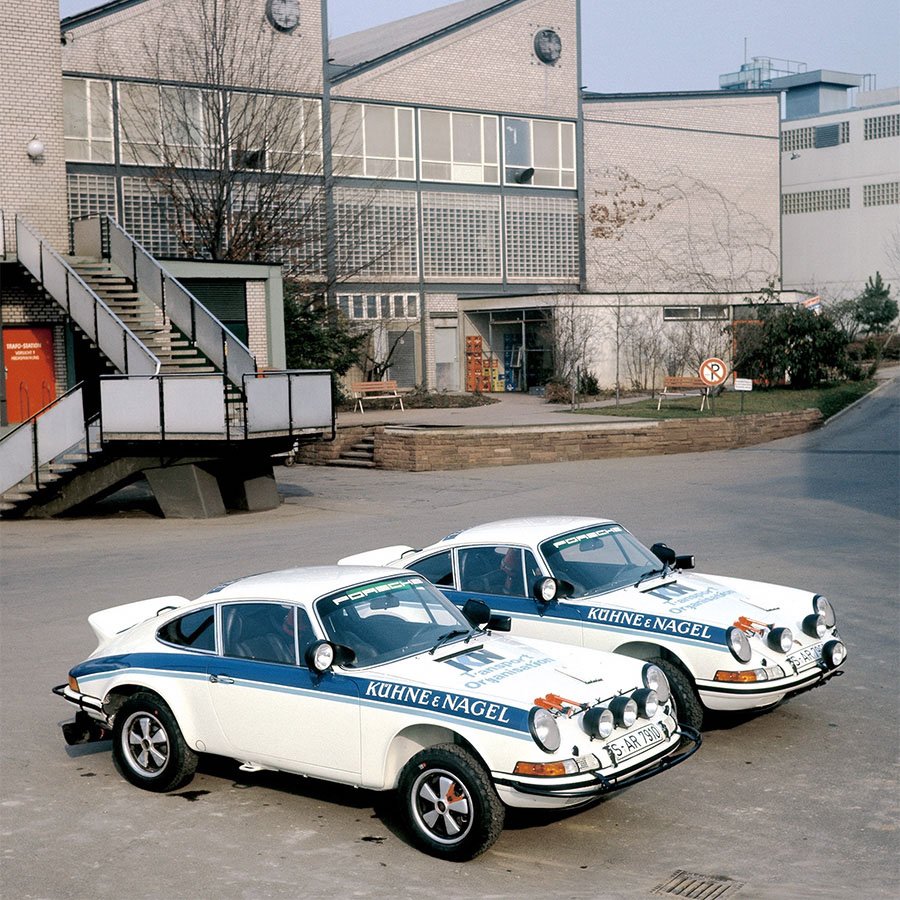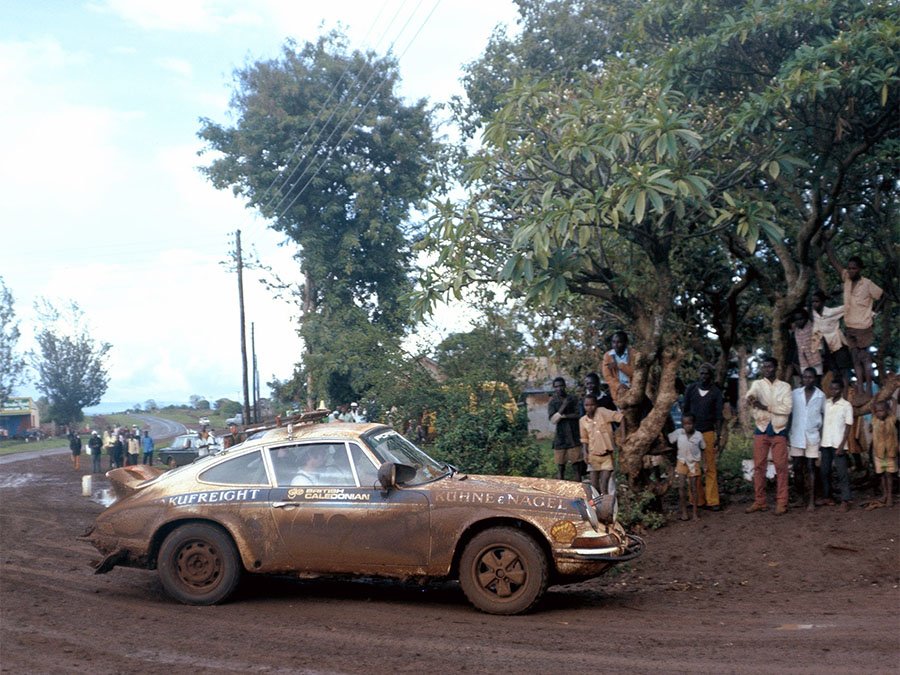Review: Porsche's 1974 Safari Rally Campaign - 911 2.7 Carrera RS
/BACKGROUND
Having seen all three of its specially prepared 911 Renn Sports retire on the 1973 Safari Rally, Porsche took another crack at the African event in 1974.
The same trio of 911s used back in 1973 were subject to a major development programme, even if from the outside they still appeared pretty much standard.
On top of the existing upgrades, around 300 further modifications were made in an attempt to address the 911’s weak spots. They included suspension with longer travel, specially developed Bilstein dampers, further increased ride height, new Pirelli tyres to replace the old puncture-prone Dunlops, more extensive underbody protection and extra spot lights.
Instead of the bright yellow colour scheme used in 1973, for this latest outing all three cars appeared in a white and blue livery with backing from Kűhne & Nagel logistics.
The two factory-owned cars were allocated to Bjorn Waldegaard / Hans Thorszelius (chassis 9113600288 – the car used by Zasada / Bien in 1973) and Edgar Herrmann / Hans Schuller (chassis 9113600285 – the car used by Waldegaard / Thorszelius in 1973).
As had been the case in 1973, the third example was entered on a preparation and service basis. It was driven by 1959 and ‘60 Safari winner, Bill Fritschy, who was accompanied by Peter Moon (chassis 9113600203).
1974 SAFARI RALLY
The 1974 Safari was round two of that year’s World Rally Championship and took place between April 11th and 15th. It followed the season opener in Portugal where Fiat’s Abarth 124 Rallye had locked out the podium positions.
Unlike in 1973 (which had seen the Safari cross into Tanzania), the 1974 event travelled a 5557km course entirely within Kenya owing to a disagreement with the neighbouring authorities.
During the week-long build up to the event, more rain fell in the region than in the previous decade ending a six year drought. It left the rivers filled and the sand beds flooded which did not bode well for the competitors that wanted a straightforward run.
More overseas drivers assembled to tackle the 1974 event than any previous Safari. In addition to Porsche, there were factory entries from Peugeot (who arrived with six 504s although only five started after one driver was injured), Lancia (a two-car team of Fulvias to include one for ‘73 winner Shekhar Mehta), Fiat (a trio of 124 Abarth Rallyes), Alpine Renault (a brace of A110s and two Renault 17s plus a semi-works R16) and Datsun (two 260Zs and a single 1800 SSS).
For the Fiat and Alpine Renault squads it was their first attempt at the Safari. Ford decided not to attend.
The rally got underway from outside Nairobi City Hall in warm sunshine, but there were soon reports of stones being thrown at the competitor’s cars. The Porsches of Waldegaard and Herrmann were both hit while one particularly unfortunate Zambian competitor lost an eye.
The field headed north-west, passed the new Kindaruma Dam and on to the foothills of Mount Kenya at which point the weather turned to heavy rain. The bad conditions continued on the very muddy Embu-Meru highway where the majority of cars had to be pushed out of trouble by locals.
Although the provisional classification at the Meru rest stop had seen the Peugeot of Timo Makinen out front having established a three minute advantage over Sandro Munari’s Lancia with Waldegaard’s Porsche a further two minutes back, the stage was eventually cancelled as around 80% of the field had struggled to get through and incurred several hours worth of delays.
After a second lap of Mount Kenya, the field headed up to Lembolio where further boggy conditions awaited. Makinen was still in the lead, but now just one minute in arrears were his Peugeot team-mates Hannu Mikkola and Ove Andersson along with the Porsche of Waldegaard. Munari’s Lancia was not far behind in fifth.
The route then turned south-west towards a rest halt at Thompson Falls. It was during this section that Waldegaard’s Porsche hit trouble when the bolts holding his rear suspension arm to the body came loose. Waldegaard arrived at Thompson Falls with just one bolt holding the arm to the torsion bar and lost 35 minutes having the clamping plate changed.
Leader Makinen was soon in trouble too; a broken cam follower allowed team-mate Andersson to briefly head the field until his car also developed issues which saw Mikkola’s Peugeot move to the top of the leaderboard ahead of Joginder Singh’s Mitsubishi Colt. Andersson and the Fiat of Paganelli were now joint third and Waldegaard was a further seven minutes back in fifth.
The second leg of the event headed north-west to Tot and then looped along via the Chesoi escarpment and Kakamenga down to Narok.
The early stages of this section saw Fritschy, who had lost half an hour on the first leg with closed points, begin to make up for lost time until he was forced to stop for 20 minutes when his 911’s battery boiled dry. Nevertheless, Fritschy was able to get going again by stopping a local driver and buying his car’s battery at not inconsiderable cost.
Near Kakamenga, leader Mikkola’s engine expired with the same cam follower issue that had affected his Peugeot team-mate Makinen earlier in the event. Before long, the other well-placed Peugeot of Andersson retired with similar trouble.
This section also saw Herrmann’s Porsche get stuck in a muddy patch on the approach to Sondu with the loss of much time.
At Kitale, the second leg entered its most difficult stage with steep, boggy and very arduous terrain. The Porsche of Fritschy seemingly got up the worst part of this section, but in doing so sustained damage to one of the front oil cooler pipes which resulted in a seized engine before the car could reach the next service point.
By the time the rally got back to Nairobi, only 20 entries were still running and Waldegaard had overhauled Singh’s Mitsubishi to lead by 36 minutes while Munari’s Lancia was a distant third.
The final leg saw many stages cancelled owing to the weather.
On the 200 mile section to Taita Hills, the front strut on Herrmann’s Porsche broke which resulted in the car hitting a bank and tearing the steering rack loose from the body.
By contrast, Waldegaard (now the sole Porsche runner) appeared to be heading for an easy win.
However, coming out of Taita Hills towards the main road at Maunga, the rear suspension arm that had given trouble on the first leg collapsed. It took well over 80 minutes to fix which dropped the Swede to second. With so few sections left, he was only able to recover 13 mins from Singh before the rally finished.
The Mitsubishi Colt of Joginder Singh and David Doig ultimately finished 28 minutes clear of the Waldegaard / Thorszelius Porsche with the Lancia Fulvia of Sandro Munari and Lofty Drews another 36 minutes back in third.
Porsche would not return for another attempt on the Safari Rally until 1978.
Text copyright: Supercar Nostalgia
Photo copyright: Porsche - https://www.porsche.com


































